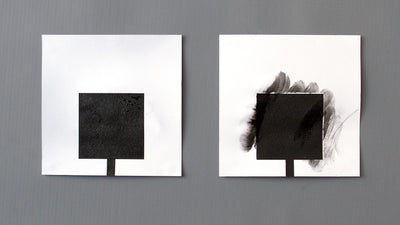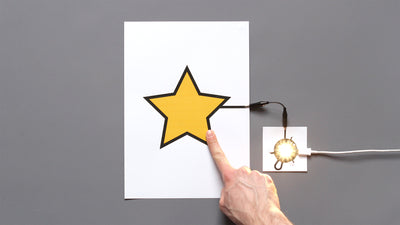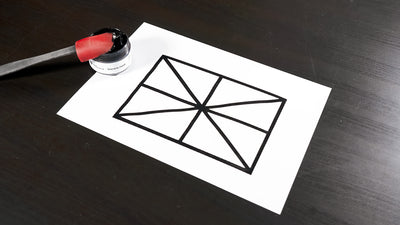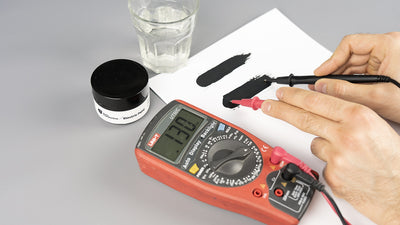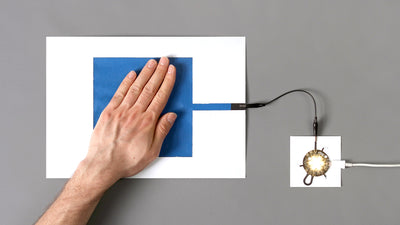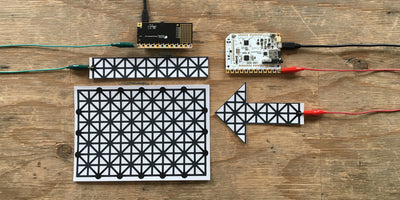Electric Paint Sensor Design Rules of Thumb

Best practice when making painted or printed sensors for Touch Board and Pi Cap projects
Electric Paint unlocks huge creative potential for interactive projects. A simple pad of Electric Paint can become a control for a light, a musical instrument, a sophisticated experiment, and so much more when connected to a Touch Board or Pi Cap. Even though Electric Paint enables huge design freedom, it's essential to understand how your designs' shape and construction might impact their electrical performance. The basic parameters that we will discuss here are fill patterns and size. These two variables generally define whether an Electric Paint sensor will be successful or not. In this tutorial, we will give you some guidelines for creating painted sensors. Following these guidelines, you should be able to design the best sensors for your specific application.
We love it when you share your projects! Post your project on Instagram, YouTube, or Twitter, and make sure to tag @bareconductive or use #bareconductive. You can also send your videos and photos to info@bareconductive.com so we can post them on our site for the world to see.
You will need:
1 x Touch Board or Pi Cap
1 x Electric Paint 10ml, 50ml or 1l
—
Sundry supplies like paper, masking tape, and paintbrushes.
Shape
Painted sensors can take almost any shape. The difference between a square or circular sensor of the same size and fill is insignificant compared to the other factors, like the thickness of the paint, length of the trace leading from the Touch Board or Pi Cap to the sensor, fill pattern, and sensor size, which we will discuss below.

Size
Small sensors (about the size of a fingertip) work best as touch-sensitive buttons, while large sensors perform better in proximity mode. As a rule of thumb, the sensor you paint should be smaller than the object you are using to trigger it. For example, if you want a button that works by lightly touching with your fingertip, then your sensor should be fingertip-sized or smaller. If you want someone to stand on a sensor to trigger it, then it should be the size of their feet. In addition to this rule, remember that larger sensors tend to work better for distance sensing. You'll need to reprogram your Touch Board to unlock the full power of this function. Also, remember that as sensors get larger, they tend to become less responsive. A large sensor (1m x 1m) might not be sufficiently responsive for your application.

Trace Length
Most of the sensors we design have a trace of between 5cm – 30cm leading up to the sensor trigger area from the Touch Board or Pi Cap. We generally make this trace between 3mm and 15mm wide.
If you need a longer trace leading to the sensor, we would not recommend using Electric Paint to make a trace longer than 1m. For traces longer than this, we would recommend using a more conductive material such as copper wire or shielded cable as the trace and then attaching the painted sensor at the end. This will improve the reliability of sensors at the end of long traces.

Fill Pattern
As discussed above, as the size of the sensor increases, its response time decreases. Among other factors, the amount of Electric Paint used to paint the sensor plays an important role in how well your sensor works. The more paint in your sensor, the slower it tends to respond. So how can you create a large sensor while minimizing the amount of paint you use? Use a hatched or gridded pattern! Using a pattern that creates a large area without filling the shape entirely with Electric Paint can help make a sufficiently-sized sensor for your application that will also be sufficiently responsive. For example, a square-shaped sensor measuring 20cm x 20cm that is completely filled in with Electric Paint will be less responsive than the same size 20cm x 20cm sensor with a hatching fill. The fill percentage and pattering is highly application-specific, but in general, a cross-hatched pattern that results in 50% fill of Electric Paint should achieve good results.



